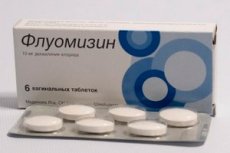Medical expert of the article
New publications
Preparations
Fluomizine in pregnancy
Last reviewed: 03.07.2025

All iLive content is medically reviewed or fact checked to ensure as much factual accuracy as possible.
We have strict sourcing guidelines and only link to reputable media sites, academic research institutions and, whenever possible, medically peer reviewed studies. Note that the numbers in parentheses ([1], [2], etc.) are clickable links to these studies.
If you feel that any of our content is inaccurate, out-of-date, or otherwise questionable, please select it and press Ctrl + Enter.

The antiseptic antifungal agent for local treatment of urogenital infections Fluomizin is allowed to be used during pregnancy, but only as prescribed by a doctor, since there is no clinically substantiated data regarding the safety of its use during the first two trimesters of pregnancy.
Indications Fluomizine in pregnancy
It is possible to use Fluomizin during pregnancy in the 3rd trimester – for the purpose of prenatal sanitation of the cervical canal and vagina in the presence of infections in them after the 34th week.
When planning pregnancy, Fluomizin is prescribed for the treatment of bacterial vaginitis (colpitis), vulvovaginitis, vaginal candidiasis (thrush), trichomoniasis and gardnerellosis.
 [ 5 ]
[ 5 ]
Release form
Fluomizin is available in the form of vaginal tablets.
Pharmacodynamics
The local therapeutic effect of Fluomizin – bacteriostatic and antifungal – is provided by dequalinium chloride, which is a cationic ammonium salt (ammonia derivative) with antiseptic and surface-active properties; according to ATX, it has the code R02AA02 and is classified as a drug for the treatment of throat diseases.
Dequalinium chloride is active against many strains of streptococcus (including group B), Staphylococcus aureus, Escherichia coli, entero- and fusobacteria, gardnerella, trichomonas, and Candida fungi.
When this substance affects bacteria and fungi, the impermeability of their cell membranes is disrupted, and then the cells themselves are destroyed.
Pharmacokinetics
The manufacturer of Fluomizin claims that when applied locally, there is little systemic absorption of the drug, which penetrates into the blood through the cervicovaginal mucous epithelium. However, studies have shown traces of the active substance in the liver, kidneys and lungs.
Biotransformation of dequalinium chloride that has entered the bloodstream occurs in the liver; inactive metabolites are excreted through the intestine.
Contraindications
Fluomizin is contraindicated in cases of cervical erosion and damage to the integrity of the vaginal mucosa, as well as for girls before defloration.
It is not recommended to use Fluomizin during pregnancy in the 1st and 2nd trimesters.
 [ 13 ]
[ 13 ]
Side effects Fluomizine in pregnancy
Side effects of this drug include: hyperemia of the mucous membrane; itching and burning in the vagina; mucous or bloody discharge after Fluomizin during pregnancy; skin rashes.
In case of increased sensitivity to the substances of the drug, hyperthermia is possible.
 [ 14 ]
[ 14 ]
Interactions with other drugs
Fluomizin is incompatible with any body wash products.
Shelf life
The expiration date of the drug is indicated on the packaging.
Attention!
To simplify the perception of information, this instruction for use of the drug "Fluomizine in pregnancy" translated and presented in a special form on the basis of the official instructions for medical use of the drug. Before use read the annotation that came directly to medicines.
Description provided for informational purposes and is not a guide to self-healing. The need for this drug, the purpose of the treatment regimen, methods and dose of the drug is determined solely by the attending physician. Self-medication is dangerous for your health.

